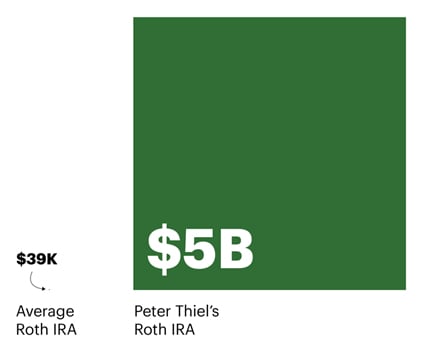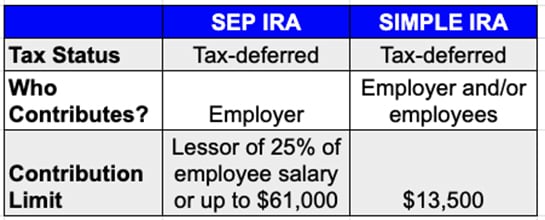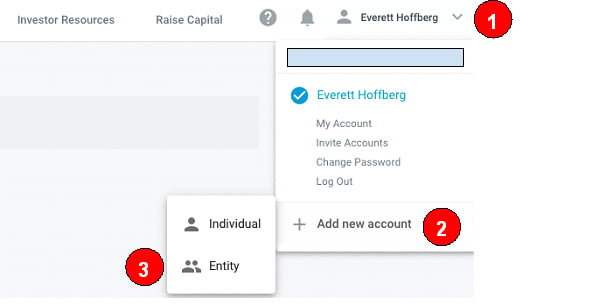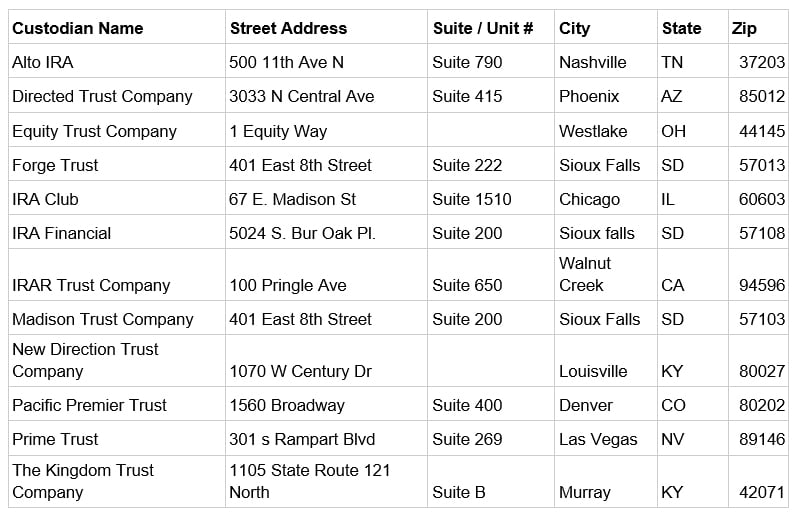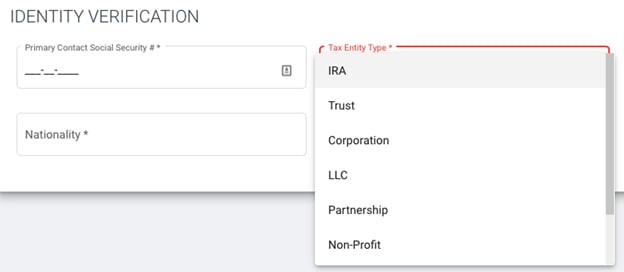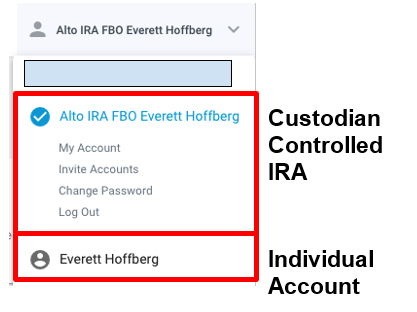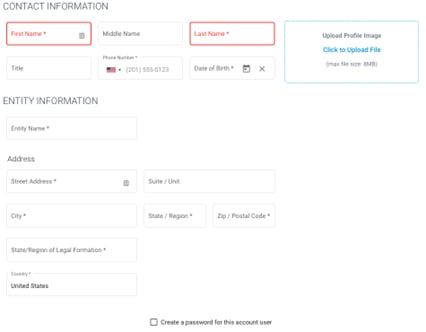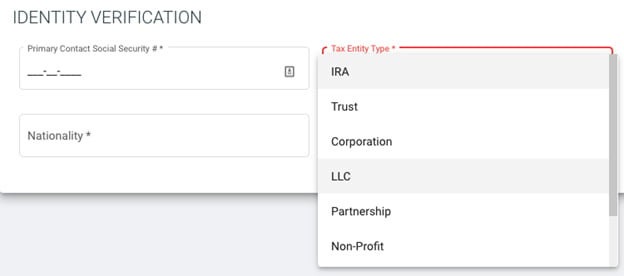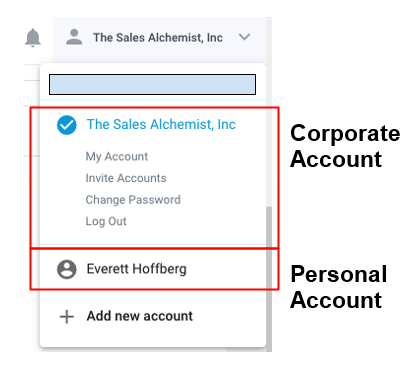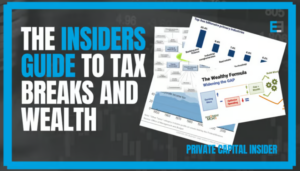Want to use your retirement accounts to invest in private investment opportunities on Equifund? Here’s what you need to know…
If you have money saved in a retirement account – like 401k, 403b, IRA, or Roth IRA – your investment options may be restricted to things like stocks, bonds, and mutual funds.
But according to ProPublica, wealthy Americans have been using their retirement accounts to invest in Pre-IPO investments to create a tax advantaged fortune!
The most notable example being the founder of PayPal – and now billionaire venture capitalist – Peter Thiel.
According to the same ProPublica article Thiel started a Roth IRA in 1999 with assets that at the time were worth less than $2,000. Those assets are now valued at $5 billion.
How did he do it? By purchasing shares of his startup, PayPal, with his Roth IRA.
Tom Anderson – the adviser and now-retired president of PENSCO Trust Company who advised Thiel and other PayPal executives in 1999 on how to invest their early shares of the company – said Thiel had the idea of putting the startup’s shares into a traditional IRA. But Anderson suggested he use a Roth IRA instead.
Thiel allegedly paid $0.001 per share – called “Par Value” – of PayPal and bought 1.7 million shares for a total investment of $1,700.
Three years later, in 2002, when eBay acquired PayPal for $1.5 billion, Thiel sold his 1.7 million shares earning a whopping $55.5 million…
All of which remained inside his Roth IRA, and he paid no taxes on the gain.
In 2004, Thiel invested $500,000 from his Roth IRA into a little known startup called Facebook. When the company IPO’d in 2012, Thiel sold about 16.8 million shares, netting $638 million.
Thiel eventually sold the rest of his shares bringing his net gain on Facebook stock to marginally over $1 billion… all tax free!
[Note: Investing in early stage companies should be considered high risk, and could result in the loss of some or all of the principal invested]
Despite the outrage of people crying foul, Thiel did nothing illegal. Instead, he – like many wealthy people – understood how to use the tax code to his advantage!
If you’d like to invest your retirement savings the same way the rich do – into alternative investments like precious metals, real estate, Pre-IPO investments, and cryptocurrency – a Self-Directed IRA is an option worth considering.
In this guide, you will learn…
- A brief history of retirement in America
- The difference between Qualified and Nonqualified Retirement Plans
- Why investors may want to consider using a self-directed IRA to invest in Reg-D, Reg-A+, and Reg-CF investment opportunities.
- The major mistakes investors make when setting up their self-directed IRA
If you already know how these accounts work and just want the step-by-step instructions on setting up your Equiifund account to invest using your retirement accounts…
- Click here to see the step-by-step instructions for investing as a Custodian Controlled Self Directed IRA; most investors have this type of account.
- Click here to see the step-by-step instructions for investing as a Self Directed IRA with Checkbook Control; we’ll talk more about this type of account in greater detail in this report.
A Brief History of Retirement in America
On Labor Day, September 2, 1974, President Gerald Ford signed into law a landmark legislation called the Employee Retirement Income Security Act (ERISA).
Prior to ERISA, employee pensions had few protections under the law. This, not surprisingly, provided opportunities for employers to “cheat” employees out of their earned retirement benefits.
With the passing of ERISA, the federal government’s role in regulating private-sector retirement plans was greatly expanded.
Not only did it make the government the guarantor of private pensions by creating the Pension Benefit Guaranty Corporation (PBGC)…
It also increased the safety of the establishment, operation, and administration of private retirement plans by delegating regulatory oversight to three federal agencies, which was a unique approach at the time.
- The Department of Labor (DOL), through the Employee Benefits Security Administration (EBSA, formerly known as the Pension and Welfare Benefits Administration) was given primary responsibility for promoting rules for reporting and disclosure. They also became responsible for determining the duties imposed on fiduciaries, who by law, are required to act in the best interests of the employees.
- The Internal Revenue Service (IRS) was given primary responsibility for participation, funding, and vesting rules.
- The PBGC was given the task of providing insurance to protect benefit promises made by sponsors of Defined Benefit plans (aka “pensions”).
ERISA covers two types of retirement plans: Defined Benefit (DB) plans and Defined Contribution (DC) plans.
Defined Benefit plans provide eligible employees guaranteed income for life when they retire.
Employers guarantee a specific retirement benefit amount for each participant that is based on factors such as the employee’s salary and years of service.
Employees have little control over the funds until they are received in retirement. The company takes responsibility for the investment and for its distribution to the retired employee.
That means the employer bears the risk that the returns on the investment will not cover the defined-benefit amount due to a retired employee.
Because of this risk, Defined Benefit plans require complex actuarial projections and insurance for guarantees, making the costs of administration very high.
Not surprisingly, corporations decided they didn’t want to bear that burden. So, they stopped offering Defined Benefit plans in favor of Defined Contribution plans.
The shift from DB to DC has placed the burden of saving and investing for retirement on employees.
A DC plan does not promise a specific amount of benefits at retirement.
They are funded primarily by the employee. However, many employers offer matching contributions to incentivize retirement savings (i.e 5% of annual salary).
These contributions are invested on the employee’s behalf.
The employee will ultimately receive the balance in their account, which is based on contributions, plus or minus investment gains or losses.
The value of the account will fluctuate due to the changes in the value of the investments.
Examples of DC plans include 401(k) plans, 403(b) plans, employee stock ownership plans, profit-sharing plans, SIMPLE IRA, and SEP-IRA.
The most common type of DC plan is a 401(k).
The major benefit of a 401(k) is it’s tax advantages: In exchange for “locking up” a portion of their salary every year, employees don’t pay income taxes on any contributions made into the plan.
This is called a deferred arrangement.
Instead, they pay taxes only when they withdraw their money (i.e. distributions) from the 401(k), which they cannot do before age 59 ½ without paying a penalty.
This means the money contributed to the DC plan grows tax free as long as it stays inside the account!
Employees who participate in 401(k) plans assume responsibility for their retirement income by contributing part of their salary and, in many instances, by directing their own investments.
There is also another form of retirement account known as a Simplified Employee Pension Plan (SEP).
This account is also a deferred arrangement, except the contributions are made to Individual Retirement Accounts (IRAs) owned by the employees.
If you’ve ever had an employer sponsored retirement plan and then left the company, you probably had to “roll over” your account balance into a Rollover IRA.
The Difference Between Qualified and Nonqualified Retirement Plans
When ERISA was passed, it also introduced a new distinction between different types of retirement plans; Qualified Retirement Plans and Nonqualified Retirement Plans
In simple terms, a qualified retirement plan is one that meets ERISA guidelines, while a nonqualified retirement plan falls outside of ERISA guidelines. Some examples:
- Qualified Retirement Plans include 401(k) plans, 403(b) plans, profit-sharing plans, Simplified Employee Pension (SEP) plans, Savings Incentive Match Plan for Employees (SIMPLE) plans, and Keogh (HR-10) plans.
- Nonqualified Retirement Plans include Roth IRAs, deferred compensation plans, executive bonus plans, and split-dollar life insurance plans.
Regardless of the plan, you may only contribute “cash” to the account.
This means you cannot “deposit” securities – like stocks, bonds, and mutual funds – directly into the account, or otherwise “assign ownership” of securities to the plan.
However, once you have contributed funds to the account, you may purchase securities directly from the account.
The tax implications for the two plan types are also different.
With the exception of a simplified employee pension (SEP), individual retirement accounts (IRAs) are not created by an employer and thus are not qualified plans.
- Qualified Retirement Plans have tax-deferred contributions from the employee, and employers may take an expense deduction on amounts they contribute to the plan.
- Nonqualified Retirement Plans use after-tax dollars to fund them, and in most cases employers cannot claim their contributions as a tax deduction.
One of the most common Nonqualified Retirement Plan investors are likely to have is the Roth IRA.
Retirement savers fund their Roth IRA account with after-tax dollars, which offer some attractive benefits:
- Your Roth IRA contributions grow tax-free.
- When you withdraw post-retirement, you won’t owe any taxes on the withdrawal amount. The amount in your Roth IRA account is yours to keep.
- You can continue making contributions to your Roth IRA account past the age of retirement as long as your income still falls within certain limits.
- Retirement savers are not required to take distributions at a certain age.
- You can choose beneficiaries to inherit your Roth IRA savings tax-free.
To avoid penalties, retirement savers must wait after the age of 59 ½ – and at least 5-years must have passed before your first contribution – to make what’s called a “qualified distribution.”
However, one of the most attractive features of a Roth IRA is that you can withdraw any contributions – meaning the funds you have personally contributed, but not any of the investment gains – you’ve made, at any time, for any reason.
Both traditional and Roth IRA accounts have annual contribution limits. For 2021 and 2022, total contributions – across all retirement accounts – cannot exceed $6,000/year if you are under 50 years old, and $7,000/year if you are 50 and over.
The annual contribution limit is just one part of the IRA contribution rules; Roth IRA contributions may be further limited if your modified adjusted gross income (MAGI) is over a certain threshold. In other words, the amount you can contribute is reduced — and eventually eliminated — at higher incomes.
This isn’t the case for traditional IRA contributions as there are no income limits. However, the amount you can deduct from your tax return phases out with higher incomes.
While traditional and Roth IRAs are typically the most commonly used retirement accounts, there are other retirement accounts that have higher annual contribution limits (along with additional conditions and restrictions).
If you have a simplified employee pension plan (SEP IRA) – most commonly used by self-employed people and small business owners – contributions an employer can make to an employee’s SEP-IRA cannot exceed the lesser of:
- 25% of the employee’s compensation, or
- $61,000 for 2022 ($58,000 for 2021 and $57,000 for 2020)
The employer is the one who makes contributions to this plan, and they must contribute an equal percentage to all employees; If you’re the business owner and contribute 10% of your wages to your SEP IRA, you’ll need to contribute 10% of each of your employees’ wages to theirs as well. If you’re a self-employed, you’d just be contributing to your account, as you don’t have any employees.
SEP IRAs work like a traditional IRA, meaning you’re not taxed on those investments until you withdraw them in retirement.
If you have a Savings Incentive Match Plan for Employees plan (SIMPLE IRA) – available for employers with no more than 100 employees, each earning more than $5,000 in the previous year – contribution limits are $13,500 for 2021 and $16,500 for employees who are 50 and over.
With this in mind, you might wind up having multiple retirement accounts at the same time.
Also, you might use different investment strategies for each account based on the different advantages and disadvantages.
Please discuss your options with a qualified financial advisor and/or tax advisor to help you decide which plans are right for your individual needs.
Why investors should consider using a self-directed IRA to invest in Reg-D, Reg-A+, and Reg-CF investment opportunities.
With many retirement accounts, your investment options are restricted to publicly traded securities – like stocks, bonds, mutual funds, exchange traded funds (ETFs), and certificates of deposits (CDs).
However, with a special IRA known as a self-directed IRA (SDIRA), investors can invest their retirement savings in the types of opportunities normally reserved for the rich.
The list of alternative investments is expansive, limited only by a handful of IRS prohibitions against illiquid or illegal activities and the willingness of a custodian to administer the holding.
The most frequently cited example of an SDIRA alternative investment is direct ownership of real estate, which might involve rental property or a redevelopment situation.
Other common examples include privately held companies stock, LLC interests, precious metals, mortgages, partnerships, private equity, and tax liens.
While there are several rules and regulations that restrict certain types of investments, the freedom this account can provide means investors have more options to grow their retirement savings.
For example, if you’d like to invest in Pre-IPO investment opportunities – just like Peter Thiel – this account lets you do that.
Additionally, because many alternative investments require longer hold times (sometimes 10+ years) before seeing a return, it can make a lot of sense to invest using funds that are already “locked up” until retirement.
Three major mistakes investors make when setting up their self-directed IRA
Before you decide to open up a SDIRA and start investing, there are two major mistakes investors make when choosing a custodian.
- The first major mistake is not having a financial plan – or a “reason why” – for how you’re going to invest your retirement accounts.
In some cases, it makes more sense to invest using your regular brokerage accounts. In other cases, it makes more sense to use a tax-advantaged retirement account.
[Note: Please consult with a tax professional to help you make this determination based on your individual needs and circumstances]
It really just depends on what types of investments you plan on making, how often you plan on making them, and when you think you’ll need access to those funds.
- The second major mistake is not understanding the fee schedule.
Potential fees include things like…
- Account opening fees
- Account closing fees
- Administrative fees
- Custodian fees
- Asset value fees
- Transaction fees
- Outbound Wire Fees
- Inbound Wire Fees
Remember, these are for profit businesses, not charities.
If you don’t understand how they make money, your retirement savings could get eaten alive by the fees… especially if you have a smaller sized IRA!
Equifund is not qualified to advise you on the tax implications of your investments. However, there are plenty of financial advisors and tax attorneys who may be able to help you minimize taxes and maximize potential returns.
- The third major mistake is not opening the correct account for your individual investment needs.
Most investors who open an SDIRA often open up something called a “Custodian Controlled IRA.”
While there is certainly nothing wrong with this option, it has it’s drawbacks; in order to make any investment, it has to go through your custodians compliance process.
Basically, this means you need your custodian’s permission to make any investments. This can result in additional fees charged by the custodian to make a transaction. It can also potentially lead to significant delays in completing the investment process as additional paperwork/documentation could be required.
For some investors, this additional administrative step – along with it’s associated costs – may be the best option.
However, if you want to have total control over how you decide to invest your retirement savings, you will need to open what is called a “Checkbook IRA.”
This is important if you plan on investing in Pre-IPO opportunities!
Why? Because not all Custodian Controlled IRAs can hold publicly traded securities.
This means if one of your Pre-IPO investments go public, you would need to transfer your shares to a separate IRA account that can hold publicly traded securities; typically, this means paying more administrative fees.
However, a Checkbook IRA – by default – can hold both private and public securities in the same account.
Here’s how Checkbook IRA’s work:
- Your IRA forms an LLC and is the only (single) member of that LLC
- The LLC has the benefit of liability protection, comparable to that of a corporation
- The IRA owner (you) becomes acting manager of the LLC
- The LLC opens a bank account in its name and funds are deposited into the account from the IRA
- As manager, you are able to write checks out of the account to acquire investments
Because the funds are held inside of a corporate entity (the LLC) and in a bank account you can control… this means you can open up an account with any broker as a “corporation” (not an IRA) and invest your retirement assets how you want to.
A Checkbook IRA can also help streamline the payment process by eliminating delays; owners can write a check – or send funds via ACH or wire – themselves versus waiting for the custodian to make payments out of the account.
A Checkbook IRA may also lower transaction fees as the custodian isn’t involved in the payment.
To be clear: when you chose this account type, you are responsible for understanding what you can – and cannot do – by the letter of the law.
Understanding permissible and prohibited transactions
To ensure that retirement accounts are used “appropriately” for actual saving and long-term investing, IRC Section 408 places some limits on the types of investments that can be held inside of an IRA.
While most types of “traditional” (i.e., publicly traded) investments are allowed – like stocks and bonds, or mutual funds (or ETFs) that hold them – IRC Section 408(a)(3) explicitly prohibits IRA assets from being invested into life insurance contracts.
IRC Section 408(m) prohibits investing IRA dollars into any form of collectibles (including artwork, rugs, antiques, gems, stamps, and coins, but not including certain gold, silver, or platinum coins or bullion).
In addition, an S corporation cannot be owned by an IRA either: IRC Section 1361(b)(1) requires all S corporation owners to be “individuals”, and by definition, an IRA is a separate entity from an individual IRA owner.
Additionally, as the owner of the IRA, you have a fiduciary responsibility as the manager of the retirement account.
As a result, the tax code requires that the assets of an IRA and its owner remain separate, and not be used in a manner where one indirectly enriches the other.
IRC Section 4975 says that an IRA owner (and anyone else responsible for the IRA account) is prohibited from commingling the financial interests of the IRA itself with its owner or any other related parties, all of whom are deemed to be “disqualified persons”.
Under IRC Section 4975(e)(2), self-directed IRA disqualified persons include:
- Any fiduciary to the account (which includes the IRA owner themselves)
- A member of the family (which includes a spouse, ancestor, lineal descendent, or a spouse of a lineal descendent)
- A corporation, partnership, trust, or estate where 50% or more of the shares/profits/beneficial-interests are owned by any of the above
- An officer, director, or 10%-or-more shareholder or partner of an entity described above
If someone – or some entity – is considered a “disqualified” person, he/she/it is prohibited under IRC Section 4975(c)(1) from any of the following direct or indirect transactions between the IRA account and a disqualified person:
- Sale, exchange, or leasing of property (even if transacted at a fair market value price)
- Lending of money or extending credit (in either direction)
- Furnishing of goods, services, or facilities
- Transfer, use, or benefit from assets
- Dealing assets for your own benefits as a fiduciary
- Receiving personal consideration as a fiduciary from a third-party that engaged in a transaction with the IRA
Basically, the government doesn’t want you to use a tax advantage account as a personal piggy bank to do things that are counter to the intended use of these accounts: to help people save for retirement.
In the event a prohibited transaction does occur, there will be consequences!
Under IRC Section 4975(a), if a prohibited transaction occurs, there is a penalty tax of 15% on the transaction in question imposed on any disqualified person(s) engaged in the prohibited transaction.
Even worse? If the prohibited transaction isn’t promptly unwound/corrected within the current tax year, the penalty tax is increased to 100%(!) of the transaction amount.
But wait, there’s more bad news…
Not only does the disqualified person(s) get smacked, so does the IRA owner.
IRC Section 408(e)(2) stipulates that the IRA itself is fully “disqualified” – which means it loses its tax-deferred status, and is treated as though it was fully liquidated in a taxable distribution as of January 1st of the tax year in which the prohibited transaction occurred.
This means the entire retirement account loses it’s tax status!
Long story short; Even though these types of violations are rare, don’t try any funny business when using these accounts.
However, there are two common ways investors put themselves at risk.
First… If you use your SDIRA to invest in real estate, you can’t rent it out to yourself (the IRA owner) or other members of your family (who are also disqualified persons)…
You cannot allow your family to stay for free in the property. You cannot hire family members to work on/in the property.
Also, you cannot transfer existing real estate you already own into your IRA.
Second… if you work with a financial advisor, there are restrictions on compensating the advisor from the IRA.
The IRA can pay an investment advisory fee as it’s a legitimate expense of the IRA itself under IRC Section 212.
However, you cannot pay the “personal” investment expenses of the IRA owner, which can disqualify the IRA. In practice, this means you cannot pay a financial planning fee.
But don’t let any of this scare you off from using a SDIRA to invest in Pre-IPO investment opportunities!
While there are always exceptions to the rule, generally speaking, you’re not going to make any prohibited transactions if you’re buying Reg-CF or Reg-A+ investment opportunities – so long as you, or a family member, does not work for the company you are investing into
Final thoughts
There are dozens of companies that offer SDIRA services. Before you decide to work with any company, just remember that it pays to shop around.
If you have a financial advisor or tax adviser, consider discussing your plans with them so they can help you properly navigate this process based on your personal situation.
Be sure to ask each provider questions about how they get paid (and what that means for you as an investor).
While some providers may appear to be “cheaper” at first glance, that doesn’t mean it’s the right solution for what you’re trying to accomplish.
It’s better to slow down, take your time, and get this set up correctly the first time than it is to rush things and have to pay more to fix avoidable mistakes.
How to invest in Equifund deals using your Custodian Controlled IRA
Before we begin…
As part of our AML/KYC compliance policies, we are required to verify your identity. As long as your individual AML/KYC clears, you will likely not be asked to submit additional information.
For more information about setting up your individual profile – along with the required AML/KYC documentation – please go here to for a walkthrough.
Once you’ve set up your individual account, you can add additional accounts to your profile.
To do this, click on the down arrow in the upper right hand corner next to your name (1), then hover your mouse over the “+Add New Account” field (2), then click “Entity” (3).
Once you do, you’ll be taken to a screen that looks like this.
Please enter your first name and last name exactly as it appears on your government issued identification. You will also need to enter your phone number and date of birth.
For the section marked “Entity Information,” the naming convention is typically [Name of Custodian] FBO [Name of Investor]; For example, Alto IRA FBO Everett Hoffberg.
In some instances, you will also need to include the [Account Number].
For example, Equity Trust Company Custodian FBO Everett Hoffberg Roth IRA #XXXXXXXXX
[Note: these are not recommendations or endorsements for any custodian mentioned in the example]
After this, please enter your, address (cannot be a P.O. Box), state, and country, of your custodian.
Here is a list of custodians other investors have used on Equifund, along with their respective information.
If for any reason, you’d like to create a separate login/password to access any additional investment accounts, you can check the “Create a password for this account user.”
Once you’ve done this, the screen will refresh and you will be taken to the homepage of your new account. You will still need to enter some additional information to complete the setup process.
The Contact Information and Entity Information will already be populated. You will need to complete the section marked Identity Verification.
Please note that any information you entered from your “Individual Account” will not transfer to this one.
This means you will need to re-enter your social security number, nationality, and country of residence.
You will also need to specify the Tax Entity Type.
Please select “IRA” from the drop down menu
To confirm the additional account has been set up, hover over the upper right hand corner.
You can switch back and forth between all of your accounts from this menu.
How to invest in Equifund deals using your Checkbook IRA
Before we begin…
As part of our AML/KYC compliance policies, we must verify the LLC is in good standing.
At the very last step of the account creation process, you will need to upload the following documents before we can process any investments made from your LLC investment account.
- Articles of Incorporation
- Operating Agreement (Signed by all members and officers)
- Proof of Adddres within 90 Days (i.e. bank statement.)
I’m also going to assume that you’ve already set up your individual profile. If you haven’t, please go here to for a walkthrough.
Once you’ve set up your individual account, you can add additional accounts to your profile.
To do this, click on the down arrow in the upper right hand corner next to your name (1), then hover your mouse over the “+Add New Account” field (2), then click “Entity” (3).
Once you do, you’ll be taken to a screen that looks like this.
Please enter your first name, last name, and title exactly as it appears on your corporate documentation (i.e. Articles of Incorporation).
You will also need to enter your phone number and date of birth.
For the section marked “Entity Information,” please enter the entity name, address (cannot be a P.O. Box), state/region of formation, and country, exactly as it appears on your corporate documentation (i.e. Articles of Incorporation).
If for any reason, you’d like to create a separate login/password to access any additional investment accounts, you can check the “Create a password for this account user.”
Once you’ve done this, the screen will refresh and you will be taken to the homepage of your new account. You will still need to enter some additional information to complete the setup process.
The Contact Information and Entity Information will already be populated. You will need to complete the section marked Identity Verification.
Please note that any information you entered from your “Individual Account” will not transfer to this one.
This means you will need to re-enter your social security number, nationality, and country of residence.
You will also need to specify the Tax Entity Type.
Please be aware than an LLC is a what’s called a “pass-through entity.”
The IRS treats one-member LLCs as sole proprietorships for tax purposes. This means that the LLC itself does not pay taxes and does not have to file a separate return from your individual return with the IRS.
As the sole owner of your LLC, you must report all profits (or losses) of the LLC on Schedule C and submit it with your 1040 tax return.
The IRS treats co-owned LLCs as partnerships for tax purposes. Co-owned LLCs themselves do not pay taxes on business income; instead, the LLC owners each pay taxes on their lawful share of the profits on their personal income tax returns (with Schedule E attached).
Each LLC member’s share of profits and losses, called a distributive share, is set out in the LLC operating agreement.
If the IRS considers you aas either a sole proprietor or partnership, please select the “LLC” option from the drop down menu.
However, you can choose to file taxes as an S-Corp or C-Corp. If this is the case please select “Corporation” from the drop down menu.
Once you make your selection, a new box will appear called “Tax Identification #.” Please enter whatever number you use to file tax returns for this entity (most commonly an EIN, a 9-digit number with a format of XX-XXXXXXX).
Please note that your tax identification number will be visible only to you on this screen. It is not visible to anyone else!
To confirm the additional account has been set up, hover over the upper right hand corner.
You can switch back and forth between all of your accounts from this menu.

